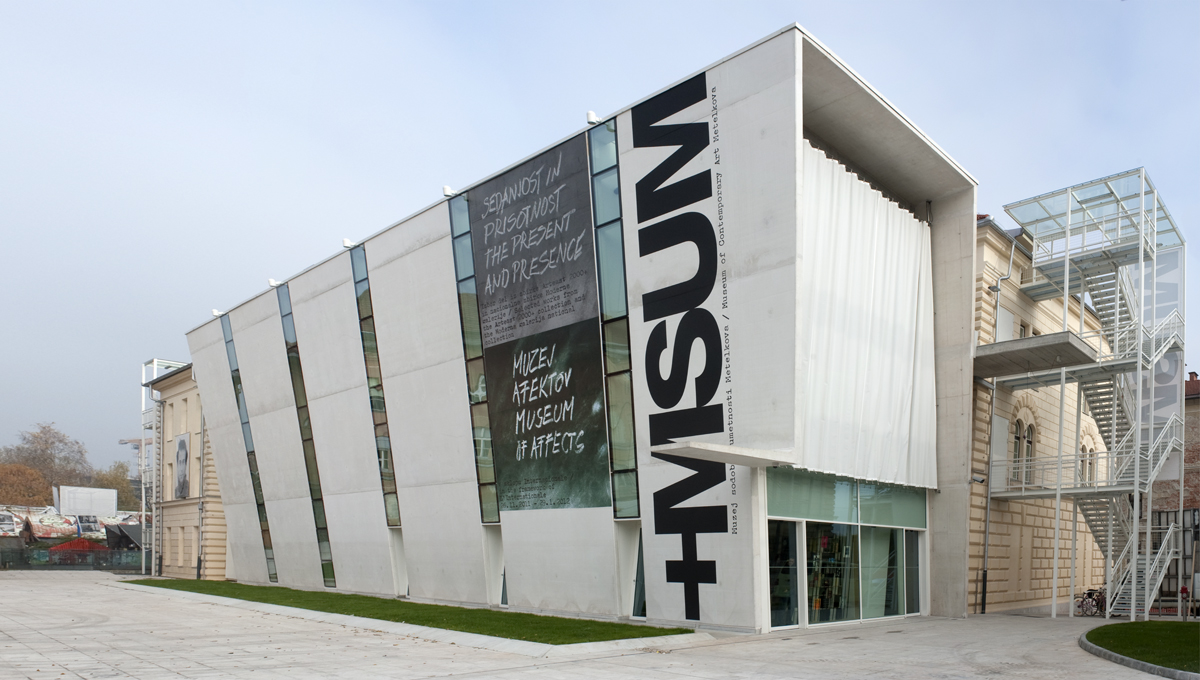Working together with the Museum of Contemporary Art Metelkova (+MSUM) and students of architecture on a project of interior design, visual artist and architect Apolonija Šušteršič developed a concept to activate part of the space on the ground floor of the museum, dedicated to informing the public, presenting connections, and exchanging ideas between the art institution, its visitors, and various local and international agents.
Entitled Impossible Retrospective (Activating the Future), the project was installed on the ground floor of the +MSUM as a temporary exhibition and a permanent display of Šušteršič’s projects when the museum opened in 2011. A continuation of this project is now included in the 1:1 exhibition. The title is a counterpoint to the standard retrospective exhibition that would usually constitute an overview of an artist’s entire body of work or presenting works from a certain period in the same place at the same time. The purpose of such exhibitions is to provide a view of an oeuvre in its entirety and present works chronologically. In the case of analyzing Apolonija Šušteršič’s work the situation is more complex and unusual. Not only is her artistic practice interdisciplinary, her projects are highly time- and context-specific, and focus on flexibility, temporality, mobility, interactivity, performativity, and connectivity. For this reason it is impossible to employ the classical model of a survey exhibition. Rather, this is a retrospective exhibition that becomes a project linked to the given situation.
The exhibition revolves around a project that is permanently in-progress and changing. Šušteršič intervenes spontaneously, leaving her objects the option of being re-contextualized depending on the need, circumstances, and context. Here context relates not just to the physical space; also the organizational or broader social contexts can call for interventions. The project is thus composed of fragments of the past, reactions to the present situation, and contemplations of the future.
The selection of projects by Apolonija Šušteršič (produced between 1998 and 2010) is limited to those that deal with the role and position of contemporary art institutions in (our) society in particular contexts, reacting to very specific situations in time. Reactivated through the interior design of the communication area, these projects now form part of the permanent content of the museum itself. Together they form a new whole that speaks about the content of the new museum, its archival material, art collection, publications, and local and international interconnectedness with other cultural institutions.
Impossible Retrospective (Activating the Future) was produced partly as an interior design project that was officially part of the architectural project, which followed a very different production process than in the art context. It provides communication spaces on the ground floor of the new museum, a chat room / a reading room, an exchange room / suggestions room and a bookshop, inviting the viewer to become an active participant – to think about and discuss institutional processes and politics within the art museum itself. There are many parallels between the work of Apolonija Šušteršič and the new museum. That is why Impossible Retrospective broaches many questions addressing artists, the art institution, and its audience. Impossible retrospective presents the opportunity to critically examine the presentation and communication of art projects, their sites and the art institutions involved.
Born in Slovenia, Apolonija Šušteršič, originally studied architecture there, before moving to Amsterdam in 1993 to pursue studies in visual arts at the Rijksakademie van Beeldende Kunsten. For the next five years, she was professor and head of Monumental Department (Department of Public Art) at the Royal Institute of Art in Stockholm. She was awarded a PhD research position shared between Lund University and Malmö Art Academy (Sweden) in 2008, where she is currently finalizing her research under the supervision of Professor Sarat Maharaj and Professor Gertrud Sandqvist.
Šušteršič has participated in a wide range of international exhibitions as well as published and exhibited projects within and beyond international contemporary art institutions, including personal shows at the Moderna Museet Stockholm, Berlin Biennale, Luxembourg City of Culture, and the twelfth Architecture Biennale in Venice. In 2012, Šušteršič was shortlisted for the Artes Mundi award, the largest cash prize awarded for the arts in the UK, exhibited at the National Museum of Wales.


